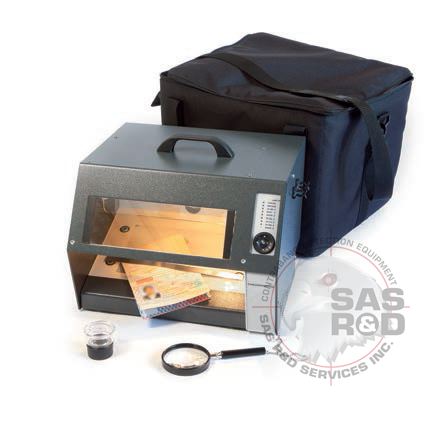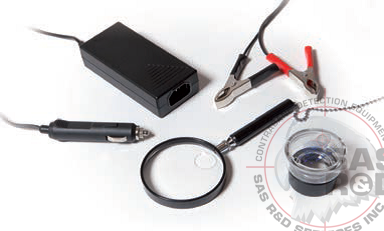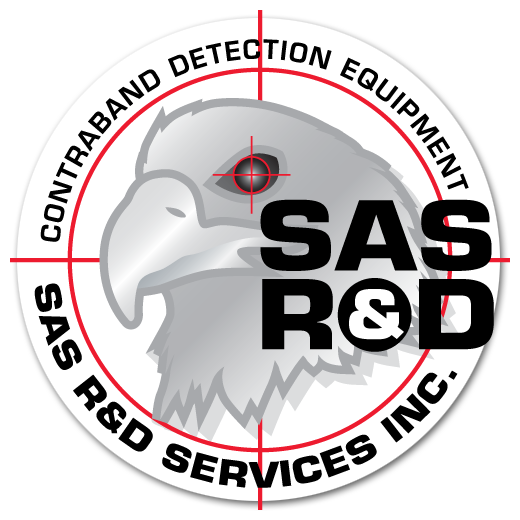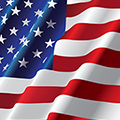CHECKPOINT-DC Portable Document Checking System
CHECKPOINT-DC Portable Document Checking System
Checkpoint - DC Specification
The Checkpoint-DC is a cost effective instrument for the examination of travel documents at border control points or for mobile patrols. Nine integral light sources allow the examination of most visual security safeguards found on the latest passports and visas, as well as offering the facility to check for alterations and additions to documents. Power can be from the local mains supply or from any 12 volt dc source, allowing the Checkpoint-DC to be used in patrol vehicles, and for transportation a padded carrying case is available as an option.
MAGNIFICATION
Magnifier
An integral 75mm circular magnifier with 3X magnification and with a local area of 6X magnification. The magnifier is attached to the Checkpoint- DC with a chain so that it may be used anywhere inside or outside the examination area. This allows maximum flexibility not provided by a fixed position magnifier; when not in use the magnifier is stored on the side of the Checkpoint-DC.
Loupe
A 10X stand loupe with a removable reticule for the checking of fine print and microprinting; the loupe is stored in a clip on the rear of the Checkpoint-DC when not in use or for transport.
LIGHT SOURCES
Overhead incident white
Two 10 watt quartz halogen for the visual examination of print quality and for checking for evidence of tampering.
Overhead incident Ultraviolet
- Three wavelengths of ultraviolet illumination for the highlighting of security safeguards or for exposing alteration and staining.
- 365nm longwave Ultraviolet
- 4 x 6 watt black light blue lamps (total lamp power 24 watts)
- 313nm midwave Ultraviolet
- A single compact 9 watt lamp with a narrow emission band at 313nm
- 254nm shortwave Ultraviolet
- A single compact 9 watt lamp
- The 313nm and 254nm lamps are housed behind a special filter which blocks any visible lights from the lamps which might interfere with the highlighting of fluorescent security safeguards.
Transmission
Three light source housed behind a transmission window in the examination area which are used to verify transmission security safeguards such as threads, watermarks, perfect resolution printing and embedded fibres.
Diffuse whiteTwo 11 watt compact lamps giving even illumination of the complete examination area, principally used for the checking of watermarks.
Spot whiteA single 20 watt halogen lamp giving an intense beam for the examination of obliterations and suspected photo substitution.
Longwave UltravioletTwo 6 watt 365nm black light blue lamps for the highlighting of paper and printed security safeguards from the rear.
Oblique
A 20 watt halogen lamp mounted at the rear of the examination area provides glancing illumination over the working area for the examination of erasures, dry stamps and indented writing.
Coaxial
A 20 watt halogen lamp to reveal retroreflective security safeguards in laminates. A narrow beam of light is reflected off the front window of Checkpoint-DC to produce a beam onto the document which is coaxial with the operator’s eyes and so hidden images may be seen.
Intensity Adjustment
The overhead incident light, oblique and coaxial lamps may be adjusted in brightness with a simple push button control.
Lamp Switching
 All the lamps are controlled from a single navigation switch assembly; a lamp is selected by pressing the up or down buttons and then pressing the OK button; the selected lamp may be switched off by either pressing the OK button again or selecting another lamp. The left/right buttons of the navigation switch adjust the brightness of the overhead incident light, oblique and coaxial lamps.
All the lamps are controlled from a single navigation switch assembly; a lamp is selected by pressing the up or down buttons and then pressing the OK button; the selected lamp may be switched off by either pressing the OK button again or selecting another lamp. The left/right buttons of the navigation switch adjust the brightness of the overhead incident light, oblique and coaxial lamps.
POWER
A switched mode external power supply with mains cable is supplied with each system. Specification: Power input 100 to 240 volts ac at 1.8 amps, power output 12 volts dc at 5 amps. Dimensions 110 x 60 x 35 mm, weight 550 grams with cable. The cable is supplied to suit local power outlets. Alternatively any 12 volt dc power supply capable of sourcing 5 amps may be used, and with suitable connecting cables the Checkpoint-DC may be run from a vehicle supply.
MECHANICAL
- Footprint: 358mm (width) x 328mm (depth)
- Height: 300mm including handle
- Weight: 6kg
- Examination area: 300mm (width) x 230mm (depth) - A4 size
DOCUMENT HOLDING
The Checkpoint-DC has a unique document holding feature which allows hands-free document examination. Two pairs of embedded magnets behind the transmission window are used with two flexible steel strips to hold documents firmly in place whilst being checked, particularly useful when examining open passport pages.
SAFETY
A system of UV blocking windows ensures that the amount of ultraviolet radiation reaching the operator is minimised. In addition, the Checkpoint-DC has detectors that switch off the 254nm and 313nm UV lamps when the operator’s hands enter the examination area.

- Light weight
- DC & mains power
- Large Examination area
- Nine light sources
- Optional carrying case
- Hands free working
- Unique safety features

OPTIONS
Carry case
A soft carrying case with a shoulder strap is available for transporting the Checkpoint-DC. The case has a tool pouch for housing the power supply and power cables and other examination tools. To order this option specify Checkpoint-DC + case
UV option
A more economical version of the Checkpoint-DC is available when the 254nm and 313nm lamps are not required, and in this option only the 365nm ultraviolet lamps are fitted. To order this option specify Checkpoint-DC / UV365
Cable option
Two additional cables can be supplied for connecting the Checkpoint-DC to either the cigarette lighter socket of a vehicle or to a battery using clips. To order this option specify Checkpoint-DC + cables
Is a 7.5 microcurie radiation source safer than 10 microcuries as competitors claim?
This paper is intended to explain the difference in the Effective Dose to humans between 2 different activities (7.5 uCi and 10 uCi) of 133Ba isotope used in a hand held contraband detector relative to ordinary risk we face in everyday life.A competitor of ours has offered a version of their unit which is 7.5 microcuries of radiation against our 10 microcuries, claiming that this is safer for the user, In fact, the increased dose to a user of a 10 uCi source over a 7.5 uCi source for a worst case scenario is essentially equal to what one gets in one second of airplane flight on a cross country trip from Washington, D.C. to Los Angeles, CA, a total flying time of up to five hours or 1 in 18,000
10 Microcurie Source
Now let’s compare both these radiation source activities and the actual working life of the source. The working life is based on the sources initial activity and the half-life of the isotope. For 133Ba, the half-life is 10.53 years. So for a 7.5 uCi source, the working life is about 35-40% less than the working life of a 10 uCi source. This translates that the dollar per dollar cost of the 7.5 uCi source is much higher than the cost of the 10 uCi source! And finally another consideration is the scanning time for the contraband detector. Excluding other factors involved, a 7.5 uCi source has 25% less photons/sec output than a 10 uCi source and this in turn increases the length of time it takes to complete a scan. This also may reduce the probability of positively identifying a concealed item (contraband)The Xpose has graphing & digital display, available tablet remote control of all functions and is MIL STD 810G - Water Resistant to IP56 (waterproof available on request) - ISO9001:2008 and most importantly sold under an Exempt Radiation License from the NRC. In other words virtually no restrictions on sale, possession of transfer of the unit.
Our competitor has none of these features.
In short, when comparing the 2 activities (7.5 uCi and 10 uCi) 133Ba sources in hand held contraband detection systems:
- No substantial increase of dose to the user, therefore no increased hazard
- 7.5 uCi lifespan of only 10 years, 10uCi lifespan of 15-20 years
- Longer time to complete a scan with 7.5 uCi
- Reduced probability of contraband detection with 7.5 uCi as compared to 10 uCi
- Exempt Distribution License from NRC ONLY for Xpose
Radiation Licensing
TO USERS OF DENSITY METERS – IMPORTANT INFORMATION:
There are several important points that users and potential users of the New Technology SAS-Hitech-Xpose Contraband Detector should be aware of. In order to simplify ownership of this device, SAS-Hitech-Xpose has been developed and licensed under United States Law as an Exempt device. Other density meters of this type are licensed under a General license. There are highly important differences between the two types of licenses. Here are a couple of the major differences:MAJOR DAMAGE OF DEVICE:
General licensed (competitors product) requirements (per their own manual):- Rope or cordoning off the area to keep people away
- Contact public health (radiological authorities) and emergency services provider for assistance
- Notify the manufacturer
Pick up unit and send it to Authorized Service Center or factory for repair (nothing more)
CHANGE OF OWNERSHIP or DISPOSAL
General license (competitors) requirements:The device is assigned to a specific location and cannot be assigned to another location without written notification to the radiation regulatory entity (State or Federal as applicable). If the device is given or transferred to another location, even if it is with the same agency (i.e. if PD Precinct 5 gives it to PD Precinct 6), a transfer of location must be filed by the user (licensee) prior to transfer. Failure to do so is subject to fine and reprimand.
Disposal of General Licensed unit: The user MUST dispose of the device as Hazardous waste and transfer to a license disposal facility. This can be done, under US law by:
- Exporting the device in accordance with NRC regulations found in 10CFR§110
- Transfer to a Specific Licensee authorized to receive the device with supporting documentation.
- Transfer to another General Licensee under strict regulations found in 10CFR§31.5(c)(9) or equivalent Agreement State regulations.
- Remove label and throw away in regular garbage.
- No restriction. It can be given it to whomever, whenever, wherever required. No paperwork/transfer licenses/authorizations required.


